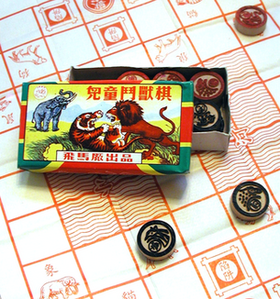Jungle (board game)
| 鬥獸棋 (Dou Shou Qi) | |
|---|---|

A typical and inexpensive Jungle set with paper board, purchased at a Chinese stationery shop
|
|
| Genre(s) |
Board game Abstract strategy game |
| Players | 2 |
| Age range | 5+ |
| Setup time | 1–2 minutes |
| Playing time | 5–30 minutes |
| Random chance | None |
| Skill(s) required | Strategy, tactics, counting |
| Synonym(s) | Dou Shou Qi The Jungle Game Jungle Chess Animals Chess Oriental Chess Children's Chess |
Jungle or Dou Shou Qi (Chinese: 鬥獸棋; pinyin: dòushòuqí; literally: "fighting animal game") is a traditional Chinese board game played on a 7×9 board. The game is also known as The Jungle Game, Jungle Chess, or Animals Chess, and is sometimes called Oriental Chess or Children's Chess.
Jungle is a two-player strategy game and has been cited as resembling the Western game Stratego, but Stratego actually has more in common with another Chinese board game known as Jun Qi (Chinese: 軍棋; pinyin: jūnqí; literally: "army game").
The goal of the game is either to move a piece onto a special square, the den, on the opponent's side of the board, or capture all of the opponent's pieces.
The Jungle gameboard consists of seven columns and nine rows of squares. Pieces move on the square spaces as in international chess, not on the lines as in xiangqi. Pictures of eight animals and their names appear on each side of the board to indicate initial placement of the game pieces. After initial setup, these animal spaces have no special meaning in gameplay.
There are several special squares and areas of the Jungle board: The den (Chinese: 獸穴; pinyin: shòuxuè; literally: "lair") is located in the center of the first row or rank of the board, and is labeled as such in Chinese. Traps (Chinese: 陷阱; pinyin: xiànjǐng; literally: "snare") are located to each side and in front of the den, and are also labeled in Chinese. Two water areas or rivers (Chinese: 河川; literally: "river") are located in the center of the Jungle board. Each comprises six squares in a 2×3 rectangle, and labeled with the Chinese characters for "river". There are single columns or files of ordinary land squares on the edges of the board, and down the middle between the rivers.
...
Wikipedia
